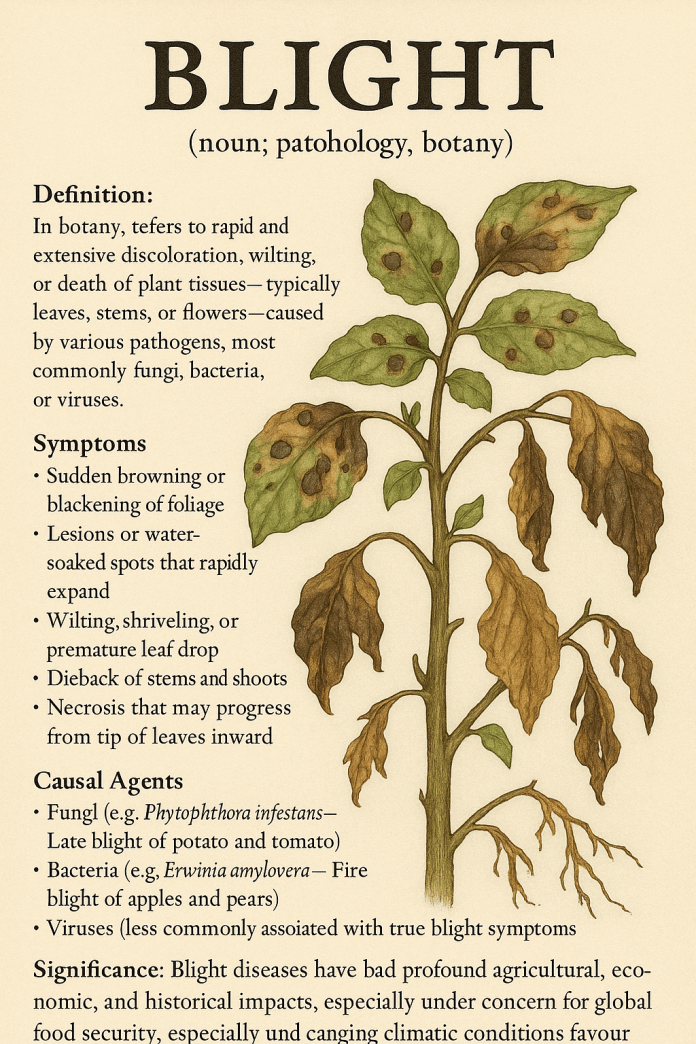(noun; pathology, botany)
Definition:
In botany, blight refers to a rapid and extensive discoloration, wilting, or death of plant tissues—typically leaves, stems, or flowers—caused by various pathogens, most commonly fungi, bacteria, or viruses. The term may also broadly describe a range of diseases or environmental conditions that lead to sudden and severe plant decline.
Etymology:
From Old English blīcan meaning “to shine or grow pale,” possibly referencing the sudden fading or browning of affected tissues.
Symptoms:
Blights typically manifest as:
- Sudden browning or blackening of foliage
- Lesions or water-soaked spots that rapidly expand
- Wilting, shriveling, or premature leaf drop
- Dieback of stems and shoots
- Necrosis that may progress from the tip of leaves inward
These symptoms often occur rapidly and may affect entire crops or plant populations under favourable conditions for the pathogen.
Causal Agents:
Blights are caused by a wide array of pathogens, including:
- Fungi (e.g. Phytophthora infestans – Late blight of potato and tomato)
- Bacteria (e.g. Erwinia amylovora – Fire blight of apples and pears)
- Viruses (less commonly associated with true blight symptoms, but can cause general decline)
- Environmental factors, such as drought, frost, pollution, or nutrient deficiency, may mimic or exacerbate blight symptoms.
Notable Examples:
- Late blight (Phytophthora infestans): Famously responsible for the Irish Potato Famine (1845–1852), this oomycete pathogen causes large, dark lesions on leaves and tubers of potatoes and tomatoes.
- Early blight (Alternaria solani): Affects Solanaceous crops like tomato and potato, typically showing concentric rings in leaf lesions.
- Fire blight (Erwinia amylovora): Bacterial disease of pome fruits, leading to a scorched appearance of blossoms and shoots.
- Southern corn leaf blight (Bipolaris maydis): Devastated US maize crops in the 1970s, particularly hybrids with Texas male-sterile cytoplasm.
Ecology and Spread:
Blight pathogens often thrive in warm, moist conditions and can be dispersed by:
- Rain splash or wind
- Insects and animals
- Human activity (tools, clothing, machinery)
- Infected seed or planting material
Many blight fungi produce spores capable of surviving adverse conditions in plant debris or soil.
Control and Management:
- Cultural practices: Crop rotation, sanitation (removal of infected debris), and proper spacing to ensure airflow
- Resistant cultivars: Development and use of blight-resistant varieties
- Chemical control: Fungicides and bactericides may be effective if applied preventively or at early stages
- Biological control: Use of beneficial microorganisms to outcompete or inhibit pathogens
- Integrated pest management (IPM): Combines monitoring, cultural, biological, and chemical strategies
Significance:
Blight diseases have had profound agricultural, economic, and historical impacts. They remain a major concern for global food security, especially under changing climatic conditions that favour disease outbreaks.
See also:
Dieback, Wilt, Canker, Necrosis, Oomycetes, Plant pathology




